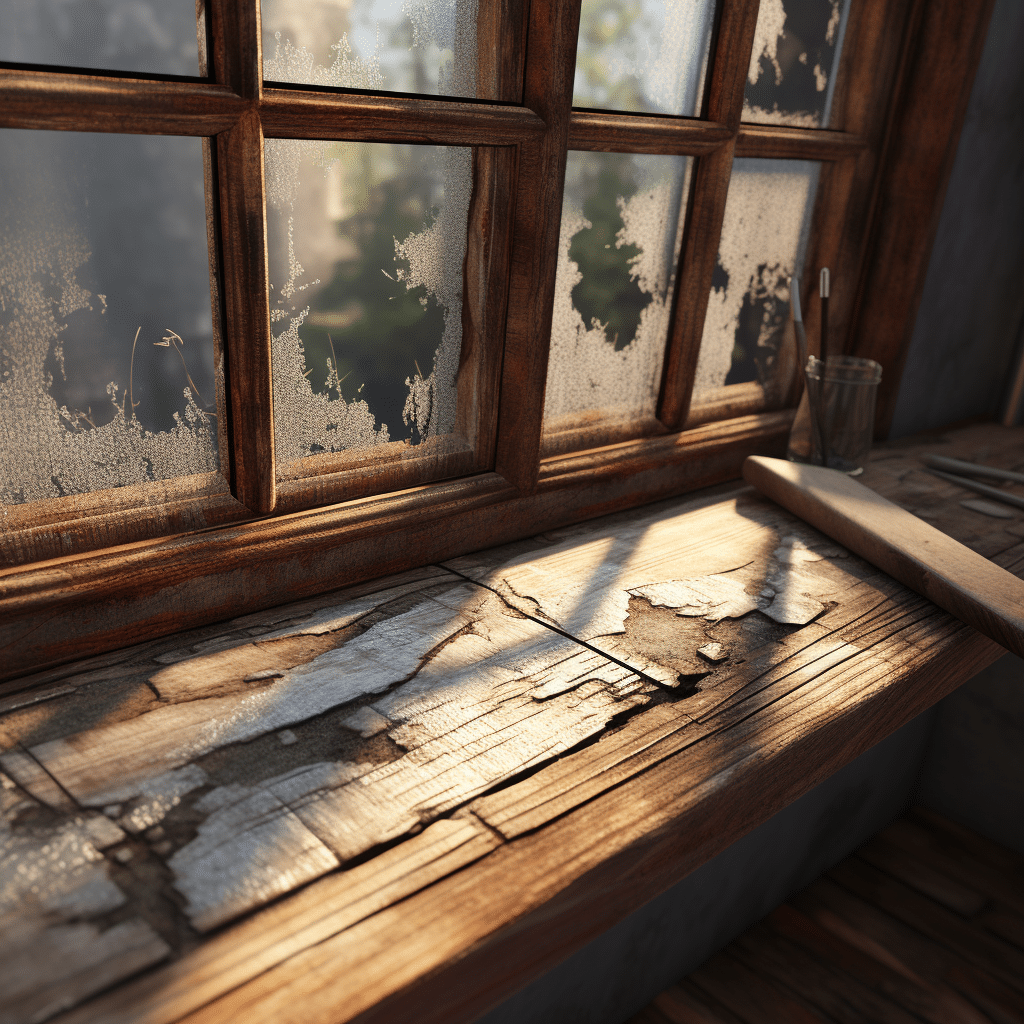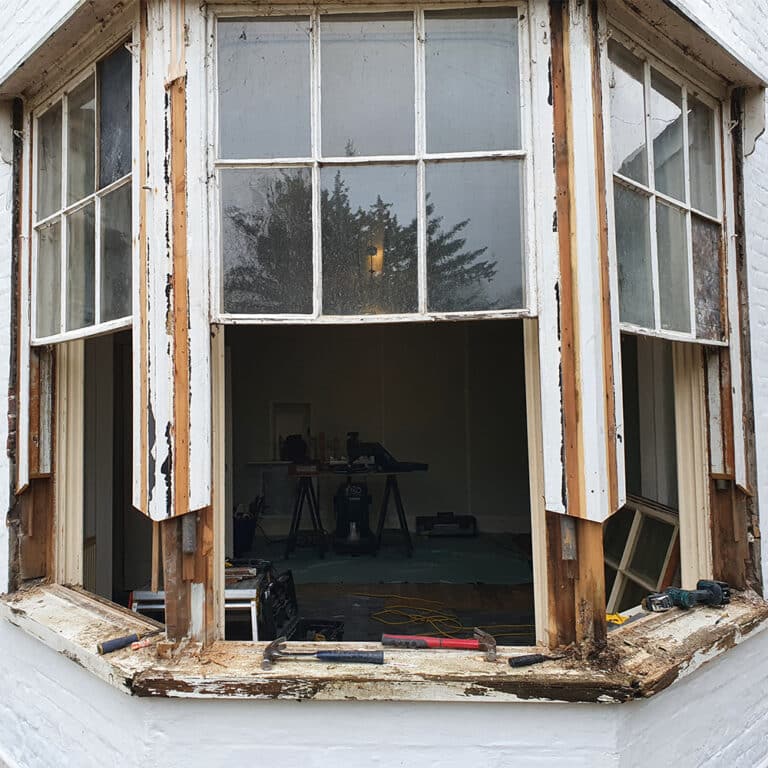How to Repair a Rotten Wooden Window
Why do Timber Windows Rot?
Timber windows can rot due to various factors, and understanding these causes is crucial for effective prevention and maintenance. Here are common reasons why timber windows may rot:
- Moisture Exposure:
- Timber is susceptible to moisture, and prolonged exposure to rain, snow, or high humidity can lead to water absorption. When wood remains damp, it creates an ideal environment for fungal growth, causing decay and ultimately leading to rot.
- Lack of Proper Sealing and Paint:
- Inadequate sealing and painting expose the wood to the elements. Without a protective barrier, water can penetrate the timber, accelerating the rotting process. Regular inspection and maintenance of paint and sealant are essential to prevent this.
- Poor Ventilation:
- Insufficient ventilation around windows can trap moisture, promoting the growth of mould and fungi. Proper airflow is crucial for keeping timber dry and preventing conditions conducive to rot.
- Insect Infestations:
- Wood-boring insects, such as termites or woodworms, can compromise the integrity of timber windows. These pests create entry points for moisture and contribute to the degradation of the wood.
- Contact with Soil:
- When timber windows are in direct contact with soil or standing water, the wood is more prone to decay. Elevated moisture levels in the ground can lead to the wicking of water into the wood, increasing the risk of rot.
- Ageing and Weathering:
- Over time, exposure to sunlight, temperature fluctuations, and other weathering factors can break down the protective layers of paint and sealant on timber windows. As the protective barriers weaken, the wood becomes more vulnerable to moisture.
- Design Flaws:
- Poorly designed windows that allow water to accumulate in certain areas or lack proper drainage may contribute to rot. Ensuring that windows are designed with effective water runoff channels and proper drainage is essential.
- Lack of Maintenance:
- Regular maintenance, including repainting and resealing, is crucial for the longevity of timber windows. Failure to address issues promptly allows small problems to escalate, leading to more extensive damage and rot.
- Quality of Timber:
- The type and quality of timber used in window construction can affect its susceptibility to rot. Some wood species are naturally more resistant to decay, while others may require additional protection. Accoya and Sapele are good choices for any replacement timber.
- Environmental Conditions:
- Harsh environmental conditions, such as constant exposure to salt spray in coastal areas, can accelerate the deterioration of timber. Understanding the specific environmental challenges in a given location is essential for proper window maintenance.

To prevent timber window rot, regular inspections, proper maintenance, and addressing issues promptly are essential. This includes repainting, resealing, ensuring proper ventilation, and taking measures to protect against insect infestations.
Why You Should Repair Rotten Wooden Windows
Repairing rotten windows offers several practical and economic advantages, making it a worthwhile endeavour. Here are some reasons why you should consider repairing rather than replacing rotten windows:
- Cost-Effective:
- Repairing a rotten window is often more cost-effective than replacing the entire window unit. Replacement can involve not just the cost of new windows but also additional expenses for installation.
- Preservation of Character:
- If your windows have historical or architectural significance, repairing them helps preserve the character of your home. It maintains the original aesthetics that might be difficult to replicate with modern replacements.
- Environmental Impact:
- Repairing windows reduces the demand for new materials and manufacturing processes, which is more environmentally friendly. It contributes to sustainability by extending the lifespan of existing structures.
- Customization:
- Original windows often have unique designs and details that may be challenging to replicate with modern replacements. Repairing allows you to retain these distinctive features.
- Energy Efficiency:
- Well-repaired windows can contribute to improved energy efficiency. Proper sealing and insulation during the repair process can help reduce drafts, leading to potential energy savings.
- Time Efficiency:
- Repairing a window is generally quicker than replacing it. This is especially important if you need to address issues promptly, such as during adverse weather conditions.
- Preservation of Home Value:
- Maintaining the original features of your home, including windows, can enhance its overall value. Many homebuyers appreciate the authenticity and charm of well-preserved, historic windows.
- Local Regulations and Permits:
- In some areas, there may be restrictions on replacing windows, especially in conservation areas, historic districts and listed properties. Repairing the existing windows may align better with local regulations and may not require planning permission.
- Personal Connection:
- Repairing your windows can create a personal connection to your home. It’s a hands-on way to care for your living space and maintain a sense of ownership and responsibility.
While there are instances where window replacement is necessary, considering repair options first can be a prudent approach. Assess the extent of damage, weigh the costs, and factor in the benefits of preserving the unique qualities of your existing windows.
The Basic Steps of Rotten Window Repair
Welcome to this practical guide on wooden window repair, with a focus on the Ventrolla approach. We’ll be exploring a systematic process to rejuvenate your windows, emphasizing a careful and detailed methodology. Whether you’re a DIY enthusiast or someone seeking a methodical restoration, this guide provides insights into inspecting, addressing, and preserving wooden windows.

Ventrolla Wooden Window Repair Guide:
- Thorough Inspection:
- Begin by conducting a comprehensive assessment of your wooden window. Mark and pinpoint areas affected by rot, and use a screwdriver to gauge the depth of damage.
- Precise Wood Removal:
- Employ precision tools like chisels to delicately extract compromised wood. Ensure thorough removal, extending beyond visible damage for a comprehensive repair.
- Preservation Application:
- Safeguard the remaining wood by applying a specialised wood preservative. This crucial step protects against future rot; adhere strictly to the prescribed application guidelines.
- Expert Filling:
- Utilize high-quality epoxy or wood filler to meticulously fill the void left by extracted wood. Layer the filler if necessary, allowing each stratum to fully cure before progressing.
- Finishing Touch – Sanding:
- Achieve a flawless surface by sanding the repaired area. Begin with coarse-grit sandpaper, progressing to finer grits for a polished finish that seamlessly integrates with the window.
- Primer Application:
- Apply an exterior wood primer to the repaired section. This serves as a foundation for the paint, ensuring optimal adhesion and an added layer of protection against the elements.
- Masterful Paint Application:
- Coat the entire window, including the repaired zone, with high-quality exterior wood paint. Opt for a paint specifically formulated for outdoor use, boasting superior weather resistance. Be careful when painting sash windows not to paint the draftproofing strips and moving parts.
- Diligent Maintenance:
- Instill a routine of regular window inspections and timely maintenance. Swiftly address any emerging issues to preempt further deterioration.
Ventrolla Pro Tips:
- Weather Wisdom:
- Choose a day with favourable weather conditions, avoiding extremes of heat or cold. Optimal weather ensures the success and longevity of your repair.
- Top-Notch Materials:
- Select premium wood filler, preservatives, primer, and paint to guarantee a durable repair that withstands the test of time.
- Timely Intervention:
- Swiftly address any signs of rot to curb its spread and prevent more extensive damage. Timely action is key to preserving the integrity of your wooden windows.
For more intricate repairs or if you seek professional expertise, consider consulting a Ventrolla specialist. Their skillset ensures meticulous restoration, bringing your wooden windows back to their original splendour.
A Customer’s Experience – and Why They Called the Experts
The first thing that I noticed on the deteriorating bathroom window was the rotten sill. The hot moisture from our daily showers. Not to mention the splashes from bathing the dog after a fox-poo-heavy walk through the woods. Or the many baths with my daughter who, at age 2, would demand to get in the tub on an almost hourly basis. But just how do you repair a rotten wooden window sill?
The first thing we did was try a bit of DIY to save some pennies. We slathered the sill in B&Q’s finest wood filler, gave it a sanding then sloshed on some white paint. Jobs a good’n! At least is was for a few weeks until we started noticing telltale water stain marks tinging the newly applied paint.
We ignored it, we had better things to spend our time and money on than a rotten casement window. And so, the showers continued, the baths continued, and the dog continued to shake excess water off her coat all over the bathroom.
The rot got worse
It became almost impossible to open and even harder to close the window. Then the rattling started. The pane of glass had become loose and any breeze would set it off making a right racket. We might have been able to live with it had our daughter’s nursery not been next to the bathroom. Any parent knows how blissful it is it to have your child sleep through the night undisturbed.
So again, we turned to DIY options. We applied tubes of sealant liberally around the pane of glass, both inside and out. The latter was via a ladder I borrowed from my father which while concertinaed seemed sturdy. However once fully extended, with me at the top and my wife below bracing it against sudden slips felt disturbingly flimsy.
We had friends stay over one weekend and during the quick tour around the room they would be staying in and the bathroom we had to explicitly say “Do not try to open or even touch that window, in fact, try not to look at it at all”.
At this point, the window sill was more filler and sealant than wood but we’d managed to stop the rattling. We got a few more months out of the window which had now become completely inoperable. Swollen with moisture and stuck in place with various B&Q products.
The final straw
It was on a particularly hot summer day, with steam building up in the bathroom that I decided to open the window using my shoulder. That didn’t go well. And this is no boast of strength.
The frame splinted and snapped, the sill split down its length and the glass slid down only stopping when it became stuck on a piece of sealant. Luckily, we were able to keep the glass from smashing into the courtyard below which would have been an almighty clean-up job to make it safe for doggy paws and baby feet.
In the end, we bit the bullet and got the experts in. After a survey it was deemed uneconomical to try and save the frame so out it went. The experts crafted and installed a completely new frame from an engineered wood called Accoya. It even matched the other windows in the house. We painted it ourselves and now we have a fully functional casement window in the bathroom that can be opened and closed with ease, doesn’t look a complete mess and is no longer an embarrassment.
Wooden window repairs and replacements from Ventrolla
To answer the question posed in the title, the best way to repair a rotten wooden window sill is to get a professional in. True it will cost more than a shelf full of wood filler, but the job will be done once and done properly. Thank you for choosing to maintain the understated charm of wooden window craftsmanship through thoughtful repairs.

